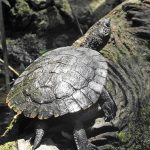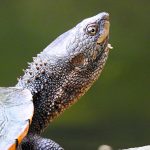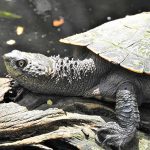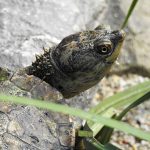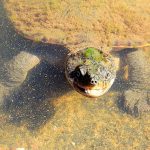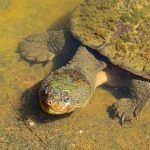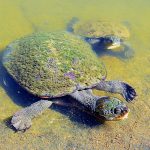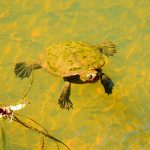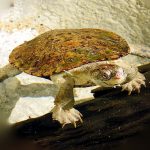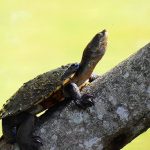SAW-SHELLED TURTLE
Saw-shelled Turtle
The saw-shelled turtle is one of Australia’s more mysterious freshwater turtles – quiet, well-camouflaged, and tougher than it looks. If you have ever watched still water in a rainforest creek or a shaded pond in eastern Australia, you may have been watched back by one of these turtles without realising it.
Quick Overview
| Feature | Description |
|---|---|
| Common name | Saw-shelled turtle |
| Scientific name | Myuchelys latisternum |
| Family | Chelidae (Australian side-necked turtles) |
| Distribution | Eastern and north-eastern Australia |
| Habitat | Freshwater creeks, rivers, dams, lakes |
| Diet | Omnivorous, strong scavenger and predator |
| Notable feature | Serrated (saw-like) shell edge and neck skin |
Where They Live
Saw-shelled turtles are found along the eastern side of Australia, mainly:
- From coastal and subcoastal Queensland
- Down into eastern New South Wales
- Also on some offshore islands (such as Fraser Island / K’gari region)
They prefer freshwater:
- Shaded rainforest streams
- Slow-flowing creeks and rivers
- Farm dams and still ponds
- Urban lakes and reservoirs, if conditions are right
Picture a quiet creek with overhanging branches, leaf litter on the bottom, and dappled light on the water – that is perfect saw-shelled turtle country.
What They Look Like
Shell and Body
The saw-shelled turtle gets its name from the jagged, saw-like edge of its shell, especially at the back. This serrated edge is most obvious in younger turtles and can wear down slightly with age.
Key features:
- Carapace (top shell):
- Usually brown to dark olive, sometimes with darker mottling
- Oval to slightly elongated shape
- Rough texture, not smooth and glossy like some other turtles
- Plastron (bottom shell):
- Cream to yellowish, sometimes with darker smudges
Head and Neck
This is a “side-necked” turtle (family Chelidae), meaning:
- It bends its neck sideways under the shell to hide its head
(instead of pulling it straight back like many Northern Hemisphere turtles)
Other head and neck features:
- Head often has small spots or patterns, sometimes a pale stripe behind the eye
- Neck skin can be slightly frilled or spiky, adding to a rough, prehistoric look
- Eyes positioned to give a good forward and side view while swimming
Size
- Shell length typically around 18–25 cm in adults
- Females are often a bit larger than males
Behaviour and Lifestyle
Daily Rhythm
Saw-shelled turtles are mostly aquatic and spend much of their time:
- Resting on the bottom under logs and debris
- Slowly patrolling their home pool or reach of creek
- Rising regularly to the surface for a quick breath of air
On sunny days, they sometimes bask:
- Climbing onto submerged logs, rocks or edges of dams
- Spreading out to warm their bodies with the sun
- Sliding back into the water at the first sign of danger
Movement and Territory
They are strong swimmers and can move between water bodies when conditions change, especially:
- During heavy rain and flooding
- When smaller pools dry up, forcing them to travel overland
They are generally shy around humans, slipping away quietly rather than showing themselves.
Diet: What They Eat
The saw-shelled turtle is omnivorous, with a diet that is both flexible and important for freshwater ecosystems.
They eat:
Animal matter
- Insects and insect larvae
- Small crustaceans
- Tadpoles and small fish
- Carrion (dead animals in the water)
Plant matter
- Soft aquatic plants
- Algae
- Fallen fruit or plant debris in the water
Ecological Role
As a scavenger and predator, this turtle helps:
- Clean up dead material, reducing disease and decay in still waters
- Keep some animal populations (like certain insects and tadpoles) in balance
In some areas, saw-shelled turtles are one of the few native predators that can handle certain invasive species, such as:
- Eating cane toad tadpoles and juveniles more safely than many other animals, which are often poisoned by them.
This ability gives them a quiet but significant role in resisting some invasive species impacts.
Reproduction and Life Cycle
Nesting
Breeding usually occurs in the warmer months. Females:
- Leave the water
- Walk to a suitable patch of soft soil or sand above the waterline
- Dig a nest chamber with their hind legs
- Lay a clutch of eggs, then cover the nest carefully
Clutch size can vary, but it is often around 8–20 eggs, depending on the female’s size and condition.
Eggs and Hatchlings
- The eggs are left to develop on their own, warmed by the soil and seasonal temperatures.
- After several months, tiny hatchlings emerge:
- Shell only a few centimetres long
- More sharply serrated shell edges than adults
- Highly vulnerable to predators, including birds, fish, goannas, and even larger turtles
Very few hatchlings reach adulthood, which is why adult survival is so important for the species.
Sensory World: How It Might Feel to Be One
To imagine a saw-shelled turtle’s world:
- Sight:
- Underwater light is soft and greenish
- Shapes of submerged branches, fish, and other turtles move slowly in front of them
- Touch:
- Cool water flowing past the limbs and head
- Mud and leaf litter under their claws when they rest on the bottom
- Warmth on the shell when they climb onto a log to bask in the sun
- Smell and taste:
- Subtle chemical cues in the water from potential food, other turtles, and predators
- The rich, earthy taste of decaying leaves and small animals mixed together in the water
Turtles use a combination of these senses to navigate, feed, and avoid danger in often murky conditions.
Threats and Conservation
The saw-shelled turtle is not currently among the most critically endangered Australian turtles, but it still faces important pressures:
Main Threats
Habitat loss and modification
- Clearing of riverbank vegetation
- Channelisation and straightening of creeks
- Dams and weirs changing natural flow patterns
Water quality decline
- Pollution from agriculture and urban runoff
- Sediment and nutrients clouding the water
Predation on eggs and hatchlings
- Foxes, dogs, feral pigs and goannas raiding nests
- Birds and large fish taking hatchlings
Road mortality
- Turtles crossing roads between water bodies, especially after rain, are often struck by vehicles
Conservation Messages (What Helps)
Even simple actions can support saw-shelled turtles and other freshwater wildlife:
Protect riparian vegetation
- Keeping or restoring native plants along creek banks provides shade, stability, and food sources
Maintain clean water
- Reducing fertiliser and chemical use
- Managing erosion and sediment run-off
Create turtle-friendly farm dams
- Providing some natural edges with plants and logs
- Avoiding full concreted or extremely steep banks
Drive carefully near wetlands and creeks
- Especially in rainy periods and warm months when turtles may be moving overland
Support local conservation efforts
- Community groups monitoring turtles and restoring waterways
- Citizen science projects that record turtle sightings
How to Tell It Apart from Other Freshwater Turtles
In eastern Australia, saw-shelled turtles can be confused with other species like the eastern long-necked turtle. Some simple differences:
| Feature | Saw-shelled turtle | Eastern long-necked turtle |
|---|---|---|
| Neck length | Medium, not extremely long | Very long, snake-like neck |
| Shell edge | Jagged / saw-like, especially in young | Smooth, rounded edge |
| General shell shape | Oval, moderately domed | Flatter, more streamlined |
| Usual habitat | Creeks, rivers, dams | Wide range, including farm dams, swamps |
Why This Species Matters
The Saw-shelled turtle is part of an ancient Australian turtle lineage, representing millions of years of evolution in freshwater environments. By:
- Cleaning up organic material
- Controlling some animal populations
- Acting as indicators of waterway health.
They help keep freshwater ecosystems functioning.
Every time we protect a creek, dam or wetland that supports turtles, we are not just helping one species – we are supporting a whole community of plants and animals that depends on clean, living water.

